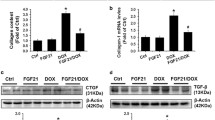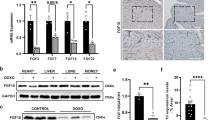Abstract
Fatty acid-binding protein 3 (FABP3) is a low molecular weight protein with distinct tissue distribution, which may play an important role in fatty acid transport, cell growth, cellular signaling, and gene transcription. We have previously shown FABP3 was more highly expressed in myocardium with ventricular septal defects than in normal myocardium and furthermore, that overexpression of FABP3 causes mitochondrial dysfunction and induces apoptosis in the P19 mouse teratocarcinoma cell line (P19), which is a suitable model for the investigation of cardiac differentiation at the molecular and functional levels. α-Lipoic acid (α-LA), a natural dithiol compound with antioxidant properties, has been reported to protect mitochondrial function in cells. In this study, we established an FABP3-overexpressing P19 cell line for the investigation of the impact of α-LA on mitochondrial impairment and apoptosis in these cells. Mitochondrial morphology was evaluated by transmission electron microscopy, while the effects of α-LA on reactive oxygen species (ROS) production, mitochondrial membrane potential (MMP), intracellular ATP content and the amount of mitochondrial DNA were analyzed by flow cytometry, a commercially available assay and quantitative real-time PCR, respectively. The results revealed that α-LA ameliorated mitochondrial deformation and decreased intracellular ROS production. Furthermore, the MMP, intracellular ATP synthesis and the amount of mitochondrial DNA were also increased. Most significantly, α-LA was shown to reverse apoptosis. Collectively, our results indicate that abnormalities in FABP3 expression contribute to mitochondrial dysfunction and apoptosis, and that α-LA represents a suitable candidate for development as a treatment for apoptosis-related congenital cardiac malformations.
Similar content being viewed by others
References
Adhikari S, Erol E, Binas B (2007) Increased glucose oxidation in H-FABP null soleus muscle is associated with defective triacylglycerol accumulation and mobilization, but not with the defect of exogenous fatty acid oxidation. Mol Cell Biochem 296(1–2):59–67
Biewenga GP, Haenen GR, Bast A (1997) The pharmacology of the antioxidant lipoic acid. Gen Pharmacol 29(3):315–331
Bishopric NH, Andreka P, Slepak T, Webster KA (2001) Molecular mechanisms of apoptosis in the cardiac myocyte. Curr Opin Pharmacol 1(2):141–150
Brown GC (1992) Control of respiration and ATP synthesis in mammalian mitochondria and cells. Biochem J 284(Pt 1):1–13
Choksi KB, Boylston WH, Rabek JP, Widger WR, Papaconstantinou J (2004) Oxidatively damaged proteins of heart mitochondrial electron transport complexes. Biochim Biophys Acta 1688(2):95–101
Crow MT, Mani K, Nam YJ, Kitsis RN (2004) The mitochondrial death pathway and cardiac myocyte apoptosis. Circ Res 95(10):957–970
Fiorina P, Corradi D, Pinelli S, Maestri R, Lagrasta C, Buscaglia M, Davalli A, Folli F, Astorri E (2004) Apoptotic/mytogenic pathways during human heart development. Int J Cardiol 96(3):409–417
Garg V (2006) Insights into the genetic basis of congenital heart disease. Cell Mol Life Sci 63(10):1141–1148
Ghibu S, Lauzier B, Delemasure S, Amoureux S, Sicard P, Vergely C, Muresan A, Mogosan C, Rochette L (2009) Antioxidant properties of alpha-lipoic acid: effects on red blood membrane permeability and adaptation of isolated rat heart to reversible ischemia. Mol Cell Biochem 320(1–2):141–148
Green DR, Reed JC (1998) Mitochondria and apoptosis. Science 281(5381):1309–1312
He L, Liu B, Dai Z, Zhang HF, Zhang YS, Luo XJ, Ma QL, Peng J (2012) Alpha lipoic acid protects heart against myocardial ischemia-reperfusion injury through a mechanism involving aldehyde dehydrogenase 2 activation. Eur J Pharmacol 678(1–3):32–38
Hoffman JI, Kaplan S (2002) The incidence of congenital heart disease. J Am Coll Cardiol 39(12):1890–1900
Katakam PV, Jordan JE, Snipes JA, Tulbert CD, Miller AW, Busija DW (2007) Myocardial preconditioning against ischemia-reperfusion injury is abolished in Zucker obese rats with insulin resistance. Am J Physiol Regul Integr Comp Physiol 292(2):R920–R926
Mannella CA (2006) Structure and dynamics of the mitochondrial inner membrane cristae. Biochim Biophys Acta 1763(5–6):542–548
Maxwell DP, Wang Y, McIntosh L (1999) The alternative oxidase lowers mitochondrial reactive oxygen production in plant cells. Proc Natl Acad Sci USA 96:8271–8276
Qian Q, Kuo L, Yu YT, Rottman JN (1999) A concise promoter region of the heart fatty acid-binding protein gene dictates tissue-appropriate expression. Circ Res 84(3):276–289
Sands AJ, Casey FA, Craig BG, Dornan JC, Rogers J, Mulholland HC (1999) Incidence and risk factors for ventricular septal defect in “low risk” neonates. Arch Dis Child Fetal Neonatal Ed 81(1):F61–F63
Skulachev VP (1999) Mitochondrial physiology and pathology; concepts of programmed death of organelles, cells and organisms. Mol Aspect Med 20(3):139–184
Song GX, Shen YH, Liu YQ, Sun W, Miao LP, Zhou LJ, Liu HL, Yang R, Kong XQ, Cao KJ, Qian LM, Sheng YH (2012) Overexpression of FABP3 promotes apoptosis through inducing mitochondrial impairment in embryonic cancer cells. J Cell Biochem 113(12):3701–3708
Tanaka T, Hosoi F, Yamaguchi-Iwai Y, Nakamura H, Masutani H, Ueda S, Nishiyama A, Takeda S, Wada H, Spyrou G, Yodoi J (2002) Thioredoxin-2 (TRX-2) is an essential gene regulating mitochondria-dependent apoptosis. EMBO J 21(7):1695–1703
van der Heyden MA, van Kempen MJ, Tsuji Y, Rook MB, Jongsma HJ, Opthof T (2003) P19 embryonal carcinoma cells: a suitable model system for cardiac electrophysiological differentiation at the molecular and functional level. Cardiovasc Res 58(2):410–422
Vergnes L, Chin R, Young SG, Reue K (2011) Heart-type fatty acid-binding protein is essential for efficient brown adipose tissue fatty acid oxidation and cold tolerance. 286(1):380–90
Witman MA, Fjeldstad AS, Mcdaniel J, Ives SJ, Zhao J, Barrett-O'keefe Z, Nativi JN, Stehlik J, Wray DW, Richardson RS (2012a) Vascular function and the role of oxidative stress in heart failure, heart transplant, and beyond. Hypertension 60(3):659–668
Witman MA, Mcdaniel J, Fjeldstad AS, Ives SJ, Zhao J, Nativi JN, Stehlik J, Walter WD, Richardson RS (2012b) A differing role of oxidative stress in the regulation of central and peripheral hemodynamics during exercise in heart failure. Am J Physiol Heart Circ Physiol 303(10):H1237–H1244
Yu T, Robotham JL, Yoon Y (2006) Increased production of reactive oxygen species in hyperglycemic conditions requires dynamic change of mitochondrial morphology. Proc Natl Acad Sci U S A 103(8):2653–2658
Zhang H, Zhou L, Yang R, Sheng Y, Sun W, Kong X, Cao K (2006) Identification of differentially expressed genes in human heart with ventricular septal defect using suppression subtractive hybridization. Biochem Biophys Res Commun 342(1):135–144
Zhu C, Hu DL, Liu YQ, Zhang QJ, Chen FK, Kong XQ, Cao KJ, Zhang JS, Qian LM (2011) Fabp3 inhibits proliferation and promotes apoptosis of embryonic myocardial cells. Cell Biochem Biophys 60(3):259–266
Zimmerman AW, Veerkamp JH (2002) New insights into the structure and function of fatty acid-binding proteins. Cell Mol Life Sci 59(7):1096–1116
Author information
Authors and Affiliations
Corresponding authors
Additional information
Lijuan Zhou and ** ** these authors contributed equally to this work.
Rights and permissions
About this article
Cite this article
Zhou, L., **, J., Song, G. et al. α-Lipoic acid ameliorates mitochondrial impairment and reverses apoptosis in FABP3-overexpressing embryonic cancer cells. J Bioenerg Biomembr 45, 459–466 (2013). https://doi.org/10.1007/s10863-013-9506-z
Received:
Accepted:
Published:
Issue Date:
DOI: https://doi.org/10.1007/s10863-013-9506-z




